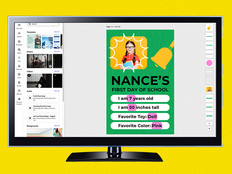What Tools Have Special Educators Used for Online Learning?
Thompson’s own students at AHM will start hybrid learning in early May after more than a year of being fully remote. Her students generally have low-incidence disabilities, including speech, vision and cognitive impairments, and most require significant support throughout the learning process.
The most important tools in the school’s distance learning toolbox, Thompson notes, are the parents, siblings and other home-based caregivers who provide assistance to the students as needed. Daily classes are held on Zoom, which students log in to using a range of devices, including Chromebooks and tablets. Some students use a switch in place of the trackpad or mouse to control the cursor on their screen, while others rely on built-in assistive technologies, such as the speech-to-type function in Google Docs.
Outside of live class time, Thompson says, she and her colleagues have turned to the student engagement platform Seesaw to produce and post videos of lessons students can access individually. “On that,” she explains, “after they watch a lesson, they can respond in a way that works best for them.” If she’s posted a list of possible answers to a question and has asked the student to pick one, for example, they might click and drag it to a box on their screen, use their device to voice- or video-record their answer, or simply type their response in the appropriate space.












